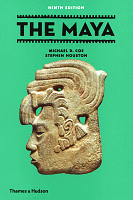Coe and Houston update this classic, highly readable account of the New World's greatest ancient civilization, incorporating the most recent research in a fast-changing field. New discoveries of spectacular stucco sculptures at El Zotz and Holmul reveal surprising aspects of Maya royalty. Dramatic refinements in dating show that rather than gradual development, there were rapid bursts of building and political formation. Other finds include the discovery in an underwater cavern of the earliest known occupant of the region, the Hoyo Negro girl, and new evidence for the first architecture at Ceibal.
It is clear that the birth of Maya civilization lies not in the Classic but during the Preclassic period, above all in the Mirador area of Guatemala with its gigantic ancient cities. The Classic Maya themselves can be understood as occupants of royal courts, full of Machiavellian intrigue yet operating in dose communion with gods and cosmos. Just-discovered texts at Xultun show a strong concern with astronomy and numerology, as well as evidence of lost books. Chichen Itza, once thought to exhibit a mish-mash of different styles, now seems again to be a city with two phases, one purely Maya, the second strongly' influenced by central Mexico.

